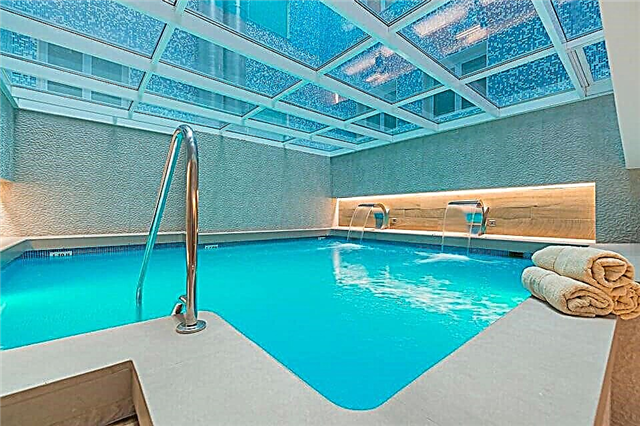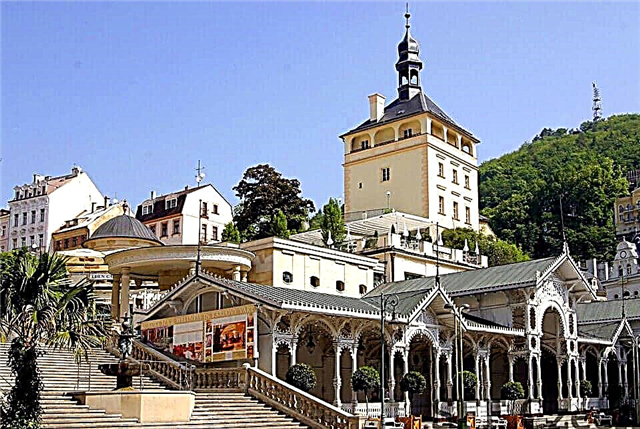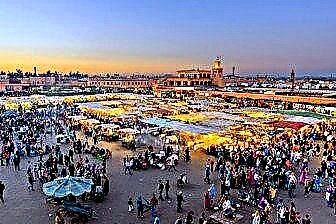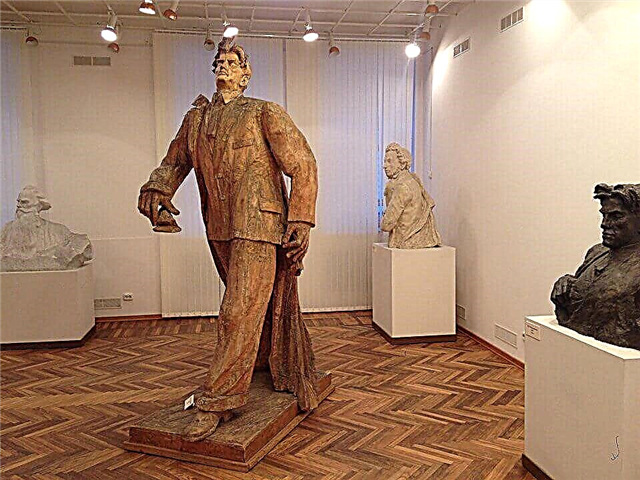This city, built on the famous route from the Varangians to the Greeks, is called the “western gate of Russia”. He more than once stood in the way of the enemy to Moscow and, like a phoenix, was always reborn from the ashes. The sights of Smolensk will tell more about him and his history. We will tell you about the most interesting places that are worth visiting in the first place.
Smolensk Kremlin

Built following the example of the Moscow Kremlin in the end of the XVI - n. XVII centuries, the fortress became one of the most mysterious and beautiful buildings. About half of what was once the largest fortification structure has survived to this day: 3.5 km of fortress walls and 18 towers out of 38 erected. The most beautiful was considered the Thunder Tower, which, according to legend, an underground passage connects with the Lithuanian rampart. In Zaaltarnaya, tourists are sure to look for the inscription "spider" left by an extreme lover.
The rest housed museums and restaurants. Standing on the way to Moscow, the Smolensk Kremlin was attacked more than once, but was not completely destroyed even once thanks to a successful design, which made it possible to fight on 3 levels at once. The fortress stopped the Poles in 1611, detained the French in 1812 and served as a refuge for the townspeople in 1941-1943. Now she keeps a message to posterity. This is the second note left in the fortress. The first, written in 1963, was read in 2013 and the next one was written, which appeals to the people of 2063.
Fortress wall

The wall of the Smolensk Fortress ranks third in the world among similar structures in length, yielding to the Chinese Wall and the Constantinople Fortress. Its length today is only 3.5 km out of the 6.5 that have been built. The height of the walls varied depending on the relief, on flat terrain it reached 18 m, near ditches and ravines it did not exceed 13 m. dr.
According to legend, the skull of a horse belonging to the patron saint of the city is immured in the walls of the fortification. And as soon as the city is in danger, a horse whinnying will be heard from the walls. Another legend warns everyone about the curse of Boris Godunov, from which anyone who tries to destroy the walls will die.
Heroes Memory Square and Eternal Flame

One of the quietest parks, the Heroes' Memorial Square, is located along the fortress wall. This is its official modern name. In 1912, when Emperor Nicholas II opened it in honor of the 100th anniversary of the victory over the French, it was called the Square of Memory of 1812. Its main attractions were the Monument with Eagles, personifying the heroes defending Russia, and the bust of Kutuzov, due to which the locals call the square Kutuzovsky.
After the liberation of the city from the Nazis, Soviet heroes were buried under the fortress wall, allegedly with the personal permission of Stalin. In 1968, a memorial sign "Eternal Flame" similar to that of the capital was installed in the park. A bronze star is placed on a granite pedestal, from the middle of which a fire bursts out, brought from the tomb of the Unknown Soldier in Moscow. Then the park began to be called the Square in Memory of Heroes. In 1987, the monuments were replenished with busts of commanders who participated in the battles of 1812.
Assumption Cathedral

On the mountain, towering over the entire city, is one of the most majestic churches in Russia, the visiting card is the Assumption Cathedral. Today tourists can see a unique architectural monument, built in 1772 a little north of the original building of the 11th century. The first Assumption Cathedral was built under Monomakh in 1101 and stood until 1611, when it was blown up by local residents during the siege by the Poles. The construction of the new cathedral began only in 1676.
Parts of the building collapsed several times, architects changed, construction was stopped and resumed. Until the architect Schedel was involved in the construction, by 1740 he had erected the 7-main cathedral in the Baroque style. The latest changes were the replacement of the 7-head top with a 5-head top due to the collapsed dome. The temple, which Napoleon liked, admired Hitler's Guderian, managed to preserve its values: the icon of the Mother of God "Hodegetria", the shroud, the relics and shoes of St. Mercury, the patron saint of the city.
Historical Museum

The Historical Museum, which is part of the Smolensk Museum-Reserve, offers tourists to learn the centuries-old history of the city and the region. Opened in 1888, it changed its name and location more than once, increased the fund and expositions. Now the museum's exhibition is presented by more than 3.5 thousand exhibits and covers the period from the ancient centuries to the 18th century. The first part of the exposition (100 thousand years BC - IX century) demonstrates the way of life, tools and living conditions of ancient people. The most interesting exhibits are a mammoth skeleton, a unique amphora korchaga, and Viking swords.
The second part (XI-XIII centuries) tells about the history of the city, which is part of the Old Russian state. Visitors will see the surviving part of the 800-year-old house, the seal of one of the first princes, birch bark letters, temple frescoes, etc. , protection from the Polish attack, Peter's reforms, etc.
Embankment

The 3-tier embankment with a well-equipped territory and landscape, benches, lanterns and a playground is a favorite walking place for locals and one of the new attractions for tourists. The history of this project goes back several centuries. The arrangement of the embankment was supposed during the restoration of the city after the Russian-French war, but it really began only in the 1920s. After the Nazi bombing, they began to rebuild it in 1980 and again the construction was stopped. The modern stage of the arrangement was supposed to end in 2013, but it is still being completed.
Now the embankment is a 3-tiered structure with inclined passages. The upper tier is a fully equipped boulevard. The rest are still being finalized. From the embankment, the length of which is 865 m, a view of a number of sights opens up: the fortress, the Assumption Cathedral, the St. John the Theologian Church and the Church of Peter and Paul.
Blonier Garden

Another project of the past is the Blonje Garden, which is officially called Glinka Park. This cozy central park appeared in 1830, when a garden was laid out on the site of the former parade ground at the direction of the governor. The trees in it were planted by the governor and officials personally, and the flower beds were laid out by the ladies of high society. The true history of the name is unknown. According to one of the interpretations, the word "Blonie" means a settlement, an outskirts and is associated with the initial location outside the city. The second - "open place for shooting" accurately reflects its essence.
The latest version refers to the Polish language, where it means flooded meadow. The park received its modern name after the establishment of the Glinka monument. The entrance to the park is decorated with figured gates; openwork forged lattices are placed in the corners. In its center there is a light and musical fountain, from which paths radiate out like rays. Among the sights there are statues of the Deer, 2 lions, Blonyovy and the stylized cafe "Russian Dvor".
Thunder Tower

In the very center is one of the 18 surviving Kremlin towers - Gromovaya. Built in n. XVII century. in addition to the main one, obtained due to the good acoustics of the dome in a thunderstorm, it has several more names. The swamps surrounding it gave the name Topinskaya, and Tupinskaya was nicknamed because of the fortress wall, which here forms an obtuse angle.
The tower was an archive, a museum, a dormitory, until in 1977 the Smolensk-Shield of Russia museum was housed in it, which in 2017 renewed its exposition. The multifaceted tower consists of 4 tiers. On the 1st there is a gift shop. The second and third ones are occupied by the exposition of the military museum, the largest exhibit of which is a model of the fortress with an area of about 5 m2... From the third tier there is an exit to the preserved part of the wall and visitors are allowed to walk along it. The upper tier is a covered observation deck; here you can hold events or take a wonderful panoramic photo.
Engelhardt House

A luxurious mansion built in the late 70s of the 18th century is an adornment of the central street. Built for the head of the city by the chamberlain A. Engelhardt, the house attracts the attention of passers-by with its unique neo-baroque style. The arched front entrance, rounded large windows, muted columns, a large parapet, attic with a round opening, pedestals with flowerpots, rich stucco are the characteristic features of this style. The facade of the house faces one of the main streets, the back side faces the park in memory of heroes. The square, 2-storey central structure expands with two rectangular wings on the sides.
Identical from the front, they are completely different. One of them is rounded in shape with many large windows - there is a large hall here. The second is rectangular - it houses a winter garden. A mezzanine rises above the central part of the mansion, making the facade of the building picturesque. There is a small well-kept garden in the courtyard of the noble mansion. Now in the mansion, erected by the architect Y. Konoplyansky, is the Wedding Palace.
Mound of Immortality

In 1970, the Immortality Mound was erected in Readovsky Park in the southwest, dedicated to more than 400 thousand people who died in the Great Patriotic War in the Smolensk region. The memorial is a 10-meter hill in the form of a 5-tiger pyramid with a 40-meter base. The land for which was taken from all cemeteries, mass graves and burials of the Smolensk region. At the top of the hill there is an 11-meter stele in the form of an open book, on the pages of which the years of the beginning and end of the war are indicated. You can get here by a staircase that climbs the southern slope of the hill.
On the northern side of the hill, between two granite slabs that represent the inclined banners, there is a copper bas-relief. In the center of it are depicted 3 warriors-defenders of the city, on one side of them partisans with a boy, on the other - a mother with a child in her arms. Rozhdestvensky's words are engraved above the bas-relief, the Eternal Flame is burning in front of him.
Memorial complex "Katyn"

There is a memorial complex 20 km from the city, which is a must-visit for all tourists. Katyn is a reminder of the political repressions of the 1930-1940s, in which more than 14 thousand people died in the forest itself. The complex, consisting of architectural, artistic and ritual structures, was opened in 2000. It is divided into 2 parts: Polish and Russian, which are united by the Memory Alley. The entrance to the complex is a glass gate between two mounds.
From them deep into Katyn, an alley leads to metal portals, passing through which you can see the museum and exhibition center, the cemetery of the Polish military, the object “Gulak on wheels” telling about dispossession, the sculpture “Shooting”, “Wall of Memory” and the burial place of the dead. Thousands of Russians come annually to honor the memory of the soldiers and lay flowers at the memorial sites, people from other countries come. In 2010, Polish President L. Kaczynski and government officials died in a plane crash near Smolensk, where they were supposed to arrive in honor of the 70th anniversary of the Katyn massacre.
Lopatinsky garden

One of the most amazing parks, which in N. XX was named the best park in Russia - Lopatinsky Garden. It was built in 1874 on the site of the destroyed Royal Bastion by the order of Governor Lopatin. For more than 140 years of existence, the park has changed and expanded significantly. From the historical landscape garden, as it was created, Lopatinsky Garden has become a cultural and entertainment garden, increasing the territory and including the entertainment infrastructure.
In addition to the monuments to the defenders of the city and the Sofia regiment, there are no less interesting places here. These are preserved towers with a fragment of the fortress wall, a bridge of sighs and an alley of stones. The moat surrounding the bastion was filled with water - now it is a small lake with a beautiful cascade and the opportunity to go boating. For lovers there is a separate corner with trees for the castles. The benches decorated with non-repeating figures are also interesting.
Museum "In the world of fairy tales"

In the center of the city, behind carved doors and a stylized signboard, there is a real kingdom of childhood and magic. Everyone who crosses the threshold of the museum turns out to be in a fairy tale. Huge wonderful chests, bulky chests, neat baskets, old hooks and cast iron - all this surrounds the visitors. The tour starts from the hall, where drawings and handicrafts of children who have already visited the museum are exhibited. The exposition includes household items, national costumes, and works of applied art.
Visitors will see carved Vologda sleds, towels embroidered by nuns, a painted chest, a German porcelain doll set, etc. The most striking event will be a meeting with fairy-tale characters, some of whom will be alive and will ask riddles. Opened in 1992, the museum combined a fun holiday, an exciting game and an acquaintance with the folklore traditions of the Russian people.
Museum "Smolensk region during the Second World War"

In the Park of Memory of Heroes, in the failure of the fortress wall, on the site of the destroyed tower, a building was erected to fit into the architectural ensemble, which originally housed a public school, and since 1973 it has been occupied by the museum "Smolensk in the years of the Great Patriotic War". The fund began with a small exposition as part of the local history museum. After being separated into a separate museum, the collection expanded significantly. Here you can find original photographs of the early 1940s, historical documents of that period, banners and uniforms, personal belongings and awards of rank-and-file servicemen, Marshal Timoshenko and generals Russiyanov and Lukin, and even a real dugout.
Among the exhibits are also German trophies. There is a voiced diorama depicting a fragment of one of the battles near Smolensk. A separate part of the exhibition is small arms of the armies of Nazi Germany and the USSR. An exposition of military equipment awaits visitors in the open air. Here are the famous Katyusha, T-34 and IS-2, the Shilka anti-aircraft gun, the MiG-23M fighter.
Art Gallery

In a 19th century mansion more like a palace, behind the red and white facade the Real School was previously hidden, now the Art Gallery is located there. The gallery's exposition is significant and can surprise even sophisticated art lovers. Part of it was donated by the Tretyakov and other galleries, the other came from nationalized estates, and the third was received as a gift from private collectors. The collection of works of Old Russian art is represented by icons from the collection of Princess M. Tenisheva.
The most famous exhibits of Russian painting are the works of Aivazovsky, Kuindzhi, Tropinin, Serov, Repin, which are not often found outside the exhibitions of megacities. There are representatives of European schools: Karacci, Strozzi, de Zurbarana, Teniers the Younger, Luttiheis, Vernet, etc. Along with painting, sculpture is also presented, among which animalistic bronze statuettes of French masters stand out. At the exhibition, visitors will find unusual German porcelain from the Maine and Vienna manufactories.
Bolshaya Sovetskaya Street

Bolshaya Sovetskaya Street is one of the oldest in the city. The staff of the Historical Museum believe that its history began in the 12th century, when it was called Bolshoy Passage. It became wider already in the 17th century by the order of Peter I, who considered it insufficient for transporting guns.At that time, it is called Molokhovskaya and connects the two ends of the city from Molokhovskaya to the Dnieper gates. In 1830, after the retreat of Napoleon's troops, who blew up the Molokhovskaya tower, the street was renamed into Annunciation in honor of the church rebuilt above the gates.
Later, it became longer due to the fact that the ditch separating it from the Troitskoe highway was filled up. The revolution changes its name again, now it is Soviet. Whatever the name of the street, it has always been an important traffic intersection and ran near the Assumption Cathedral and the Trinity Monastery. On it is the House of Books and the former Merchant Assembly, the House of the Red Army, the House with a Clock, etc.
Railway station building

The first railway station "Western Gate" of Russia was built in the neoclassical style. Because two branches went through the city: Orlovsko-Rizhskaya and Moskovsko-Brestskaya, and on the platform of each of which a separate building was erected, the first station united them with an arched structure with a clock. In the summer of 1941, it was so destroyed by a fascist air raid that there was no talk of rebuilding it.
The station reappeared already in 1952. According to the project of Mezentsev and Shpotov, they erected a monumental three-tiered structure in the spirit of the era. The central facade of the structure is distinguished by an arched opening with a colonnade. The entire building is decorated with decorative edging, platbands, incomplete columns, belts, medallions and rosettes. The interior of the station is no less intricate. High vaults supported by columns, luxurious stucco and Empire chandeliers, marble and granite in the walls and floors. And against the background of this splendor, huge paintings by Serov, Shishkin, Buldakov and others.
Deer Sculpture

The sculpture of a bronze Deer has become a decoration of the Blonier garden and a favorite photo zone of all kids. Installed after the Second World War, it is surrounded by legends and overgrown with traditions. In 1945, a huge box was unloaded from a carriage that had arrived from Konigsberg onto the platform with the inscription: "To the children of Smolensk from the soldiers of the N Guards Regiment." The box contained a Deer sculpture, which it was decided to install in the garden. According to one of the versions, the bronze statue by the famous animal painter R. Frize was a war trophy taken from Goering's hunting lodge.
The sculpture itself was created for Emperor Wilhelm II, a passionate hunter who wanted to immortalize his favorite specimen. It is believed that if you rub a deer, then luck will surely accompany. And graduates of a military school, for good luck, should drink from a sawn-off horn (which weighs about 200 kg). Because of these signs, the statue has already been restored several times.
Gnezdovsky burial mounds

One of the largest in Russia archaeological museum-reserve "Gnezdovo" is located 12 km from the city. Little remains of the settlement, which was located here a little over 1,000 years ago: a complex of burial mounds, a settlement and ancient Russian monuments. It was discovered by chance during the construction of the Vitebsk-Orel road. The workers were surprised by artificial embankments; later, decorations were found, which are exhibited in the Hermitage. The invited historians and archaeologists are still excavating the settlement and the settlement, supplementing the information already obtained about the life, traditions and rituals of the people who lived here.
The complex stretching for 3 km is a storehouse of amazing finds, including pagan amulets, Slavic temple decorations, Scandinavian brooches, various weapons, tools, etc. The best time to visit this attraction is mid-August, when the historical festival takes place here. This is a reconstruction of the life and life of ancient Russia with fairs and tournaments.
Monument to the Sofia Regiment

The merits of the Sofia Infantry Regiment, which participated in the Battle of Smolensk during the Patriotic War of 1812, were immortalized by grateful descendants in a symbolic memorial obelisk. It was installed in the Smolensk "Lopatinsky Garden" on the territory of the Royal Bastion. Today, this monument, erected a century after the end of the war with Napoleon, is one of the federal cultural heritage sites of the peoples of the Russian Federation.
The majestic rectangular obelisk is crowned with the figure of an eagle, proudly spreading its wings. According to the idea of the author of the monument - sculptor and artist B.N. Tsapenko - in the lower part of the pedestal there were bronze plaques on which stories about the exploits of the Sophia regiment were engraved, but today only two of the six memorial plaques have survived, the rest are under reconstruction. Installed at the expense of officers and soldiers of the Sofia regiment, the memorial obelisk was badly damaged during the formation of Soviet power and during the German occupation of Smolensk in 1941-1943.
The first restoration of the monument was carried out in 1960, then restoration work was needed in 2011, when the unique monument was already in disrepair. Currently, the monument has been restored and is available for inspection, and the city authorities are deciding on the improvement of the adjacent territory.
Monument to Fyodor Kon

In the list of attractions, the monument to Fedor Kon is considered one of the most visited historical and cultural monuments. Its inspection is included in most excursion programs, and tourist guides put it on the first pages of their review.
The character on the monument identifies the collective image of Fyodor Savelyevich Kon, a Russian architect who lived in the second half of the 16th - early 17th centuries. In the history of his country, he became famous for the construction of the tower and city walls, erected in the period from 1596 to 1602 and preserved to this day intact. Another outstanding achievement of the talented architect was the walls and towers of the Moscow "White City" built in 1585-1593.
Historians have never been able to find any evidence of the appearance of a skilled craftsman, so the figure on the monument is only a tentative image. Komov and Anipko became the authors of the monument to Fedor Kon, and its grand opening near the fortress tower happened in 1991.
Monument "Scorched Flower"

Full of symbolic meaning, designed to serve as a reminder to descendants of the horrors of war and the crippled fate of children, the "Scorched Flower" monument was created according to the project of A.S. Parfenov in 2005. It is dedicated to children who, by the will of fate, became prisoners of concentration camps set up by the Nazis in Europe.
The "Scorched Flower" is located near the intersection of Victory Square with Barclay de Tolly Street in the Park of Pioneers. In the lower part of the monument there is a memorial plaque, which lists the names of children's concentration camps. The initiator of the construction of the monument was the Smolensk regional organization "Former juvenile prisoners of fascist concentration camps."
Cathedral mountain

Cathedral Mountain is its main decoration, an object of pride, and a kind of place of power. Having become a true symbol of the city, this attraction attracts the attention of tourists, who are gladly told by the guides about its importance. In the 9th century, an administrative, cultural and religious center was located on this place raised above the river. The elevated location made the city presentable and served as an excellent strategic advantage in the event of military attacks.
At the very beginning of the 12th century, the first stone cathedral was built here, named after the Assumption of the Most Holy Theotokos. Unfortunately, the cathedral did not survive the invasion of the Poles at the beginning of the 17th century, but in its place already in 1677 a new architectural ensemble was laid, the construction of which took more than a century. The new Cathedral of the Dormition aroused admiration of both Russian rulers and the common people.
By a happy coincidence, neither the Cathedral Mountain, nor the Orthodox complex of the Assumption Cathedral have suffered in the course of history and have survived almost unchanged.Today, on Cathedral Hill, tourists can see not only the main church, but also the magnificent grand staircase, the bishop's chambers, the building of the former consistory, a bakery, a religious school, and from the observation deck you can admire the beauty of the city and its environs.
Square in Memory of Heroes

One of the most significant memorial complexes is the city square in memory of heroes, located in the very heart of the city near the walls of the Smolensk Kremlin. The soldiers who died during the bloody battles for the Fatherland are buried here. The memory of them is carefully kept by their descendants, and their names are immortalized on memorial tablets, in the lists of which there are several dozen surnames.
The Square in Memory of Heroes is an analogue of the famous burial in Moscow on Red Square. The ashes of the heroes of the Patriotic War of 1812 and the Great Patriotic War are buried here. The square was founded in 1912 - the centenary of the victory over Napoleon. The opening ceremony of the park, which took place on the last summer day of 1912, was led by Emperor Nicholas II.
Museum of Sculpture S.T. Konenkova

The opening of the Konenkov Museum took place in the spring of 1973 at the initiative of the sculptor himself, who during his lifetime expressed a desire to create an exhibition center for his creations in his small homeland. Initially, the artist's creative workshop was based exclusively in Moscow, but after the transfer of more than four dozen works to the Smolensk region, the creation of a new exhibition was initiated.
On this occasion, Konenkov wrote that he was donating his art to his dear fellow countrymen. Subsequently, the author's collection was repeatedly replenished from the funds of the Ministry of Culture, private collections, the Volgograd Art Museum and other museums of Russia. Today, visitors have access to about a hundred works of the master, of which fantasy and fabulous sculptures are especially fond of.
The museum is located on Mayakovskogo street, 7. It is open from 10 to 18 hours daily, except Monday. On Friday, the museum closes one hour earlier than usual. On Wednesdays at the end of the month there is a cleaning day at the museum.











